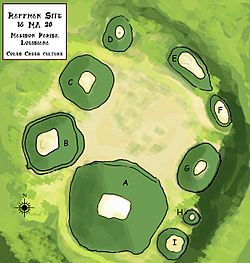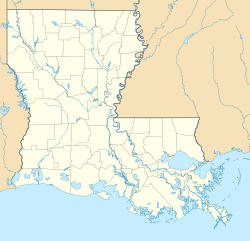Raffman Site facts for kids

Diagram showing the arrangement of plaza and platform mounds at site
|
|
| Location | Waverly, Louisiana, Madison Parish, Louisiana, |
|---|---|
| Region | Madison Parish, Louisiana |
| Coordinates | 32°28′23.92″N 91°20′46.97″W / 32.4733111°N 91.3463806°W |
| History | |
| Founded | 500 BCE |
| Abandoned | 1200 CE |
| Periods | Balmoral Phase |
| Cultures | Tchefuncte culture, Coles Creek culture |
| Site notes | |
| Excavation dates | 1981, 1998, 2000, 2002, 2004 |
| Archaeologists | Tristram R. Kidder, Lori Roe |
| Responsible body: private | |
The Raffman Site is an archaeological site in Madison Parish, Louisiana. An archaeological site is a place where people lived or did things a long time ago. This site was built by ancient people between 700 and 1200 CE.
People from two main groups, the Tchefuncte culture and the Coles Creek culture, lived here. The site was most active during the Coles Creek period, especially between 1000 and 1100 CE. By 1200 CE, most people had left the Raffman Site.
What Does the Raffman Site Look Like?
The Raffman Site is very large. It has nine platform mounds built around a central open area called a plaza. A platform mound is a raised area of earth, often flat on top, used for buildings or ceremonies.
The plaza is about 90 meters (295 feet) long and 100 meters (328 feet) wide. Mounds A, B, C, D, E, and G are close to this central plaza. Mounds H and I are a bit further away, next to Mound A.
Mound A is the biggest mound at the site. It is located on the southern edge of the plaza. This huge mound is about 12 meters (39 feet) tall. Its base is about 75 meters (246 feet) by 100 meters (328 feet).
When Were People Living Here?
Archaeologists have studied the Raffman Site to learn about its history. They found signs of people living there during the Woodland period. This was a long time ago, even before the Coles Creek culture.
- Early Woodland Period: The first signs of people are from the Tchefuncte period (600 BCE to 200 CE). These older layers are found underneath the later mounds.
- Middle and Late Woodland Periods: After the Tchefuncte period, people continued to live at the site.
- Coles Creek Period: Around 700 CE, the people at the site began building large, flat, and cone-shaped mounds. By 1000 CE, during the Coles Creek period, there was a big building project. They changed the plaza and added more mounds.
- Abandonment: Around 1200 CE, the Raffman Site was mostly empty.
How Do We Know About the Site?
The Raffman Site was first mentioned by archaeologists Philip Phillips and Robert Neitzel in 1954. For many years, not much research was done there.
However, starting in the late 1990s, archaeologists began to study the site more closely. Tristam R. Kidder led excavations in 1998 and 2000. Later, Lori Roe and Kidder worked together on excavations in 2002 and 2004. These digs helped us learn a lot about the ancient people who lived at the Raffman Site.


